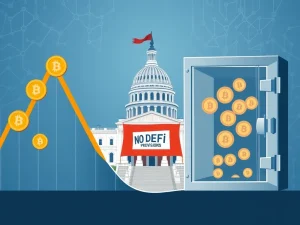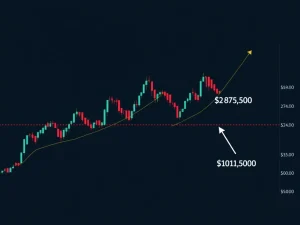Bitcoin & Ethereum: Arthur Hayes Forecasts Explosive $250K BTC, $10K ETH by 2025

Imagine a world where Bitcoin soars to $250,000 and Ethereum reaches $10,000 within the next couple of years. This isn’t just a fantasy from a speculative investor; it’s a serious crypto prediction from Arthur Hayes, the co-founder of BitMEX, a prominent figure known for his audacious and often prescient market insights. His latest forecasts, outlined in a recent blog post, have ignited considerable debate across the digital asset landscape. But what exactly underpins such ambitious targets, and are they truly within reach?
Arthur Hayes’ Audacious Outlook for Bitcoin and Ethereum
Arthur Hayes has once again captured the cryptocurrency world’s attention with his incredibly bullish 2025 targets for the two largest digital assets. He projects Bitcoin to hit a staggering $250,000 and Ethereum to reach $10,000 by the end of 2025. These aren’t minor bumps; they represent compound annual growth rates of over 111% for Bitcoin and a remarkable 179% for Ethereum from their current levels. Such figures demand a deeper look into the rationale behind them.
Hayes attributes this anticipated rally not to mere speculation, but to a profound analysis of structural shifts in global capital flows. His perspective hinges on a future economic strategy he terms ‘credit-heavy,’ particularly under a hypothetical Trump administration. He draws parallels to wartime mobilization models, where industrial output in critical sectors like rare earths and defense manufacturing takes precedence. This unique economic framework, Hayes argues, creates an environment ripe for risk assets, with cryptocurrencies poised to be major beneficiaries.
Unpacking the Macroeconomic Drivers: Capital Shifts Fueling Crypto Growth
At the heart of Arthur Hayes‘s bullish thesis lies a nuanced understanding of macroeconomic forces and their interplay with the nascent crypto market. He posits that the expansion of credit, fueled by specific government policies, will inevitably spill over into digital assets. This is where his concept of the ‘credit waltz’ becomes critical.
The ‘Credit Waltz’: Stablecoins and Government Debt’s Symbiotic Dance
One of the most intriguing aspects of Hayes’ analysis is his focus on the symbiotic relationship between stablecoins and government borrowing. He highlights how stablecoin issuers are increasingly channeling their vast user deposits into U.S. Treasury bills. This dynamic serves a dual purpose:
- Funding Federal Deficits: Stablecoin reserves, often held in short-term government debt, effectively help fund federal deficits.
- Recycling Capital into Credit Creation: As these deposits are channeled into T-bills, the capital is recycled back into the traditional financial system, expanding the credit supply. This expanding credit, in turn, fuels demand for digital assets.
This ‘credit waltz’ suggests a profound, albeit indirect, connection between crypto and traditional finance, where an expanding credit supply creates a fertile ground for the growth of digital assets like Ethereum and Bitcoin. It’s a feedback loop where the more credit that’s created, the more capital flows into the crypto ecosystem.
Regulatory Tailwinds: A Catalyst for Unprecedented Crypto Adoption?
Beyond macroeconomic shifts, Hayes also points to potential regulatory changes as a significant catalyst for his ambitious crypto predictions. He speculates that a new U.S. administration, particularly under a hypothetical Trump presidency, might introduce reforms that could fundamentally alter the investment landscape for digital assets. These potential reforms include:
- Allowing 401(k) Investments in Crypto: Opening up retirement accounts to direct crypto investments could unlock a massive pool of institutional capital, providing a direct pipeline for retail and institutional funds into the market.
- Exempting Digital Assets from Capital Gains Taxes: Such an exemption would significantly reduce the tax burden on crypto profits, making digital asset investments far more attractive and potentially incentivizing long-term holding.
These policy shifts, if enacted, could catalyze unprecedented institutional adoption, transforming the perception and accessibility of assets like Bitcoin and Ethereum from niche investments to mainstream financial instruments. The regulatory environment has always been a key determinant of crypto’s growth, and Hayes’ outlook suggests a potentially favorable shift on the horizon.
Navigating the Immediate Horizon: Technical Insights vs. Long-Term Vision
While Arthur Hayes paints a compelling long-term picture, it’s crucial for investors to acknowledge the immediate market realities and technical indicators that present both challenges and opportunities. The journey to these lofty 2025 targets is unlikely to be a straight line, and short-term volatility remains a constant factor.
Bitcoin’s Current Hurdles: Volume and Resistance
Bitcoin, currently trading near $118,200, has shown some concerning signs from a technical perspective. Despite an 8.7% weekly gain, its 24-hour trading volume has seen a decline, signaling weaker momentum. James Check of Glassnode, a respected on-chain analytics firm, notes that this lack of volume growth raises doubts about the likelihood of Bitcoin hitting the $200,000 milestone, let alone $250,000, in 2025. For the bullish case to truly validate, Bitcoin must convincingly clear key resistance levels at $130,000, $140,000, and $150,000.
Ethereum’s Relative Strength and On-Chain Signals
In contrast to Bitcoin, Ethereum has shown stronger relative performance, trading at $3,688 after a 1.2% 24-hour rise. On-chain metrics paint a more optimistic picture for ETH, indicating growing utility and network activity:
- A significant 475% surge in network fees, suggesting increased demand for block space.
- Rising daily active addresses, indicating growing user engagement.
Technical analysts highlight a bullish Cup & Handle pattern and a rising channel on Ethereum’s chart. Fibonacci projections point to potential multi-year targets of $5,790, $8,513, and even $13,000. However, short-term volatility persists, particularly as ETH approaches the $4,100 level, which could trigger corrective movements before resuming an uptrend. Hayes’ revised Ethereum target of $10,000, initially stated in July 2025, reflects renewed institutional interest in the asset, including a notable 52% price surge over 30 days and increased ETF inflows.
Beyond the Numbers: The Broader Implications for 2025 Targets
The debate surrounding Arthur Hayes‘s bold crypto predictions underscores a fundamental tension in market analysis: the interplay between long-term fundamental drivers and immediate technical realities. While Hayes’ vision of a credit-fueled economy and favorable regulatory shifts aligns with powerful long-term bullish narratives, immediate price action reveals a fragmented landscape where momentum can quickly shift.
Investors are advised to adopt a balanced approach. This involves monitoring macro-level structural developments, such as stablecoin growth and potential regulatory clarity, which could serve as powerful tailwinds. Simultaneously, paying close attention to near-term technical levels and on-chain metrics for both Bitcoin and Ethereum is crucial for navigating market volatility and assessing the viability of these ambitious targets.
Conclusion
Arthur Hayes’ 2025 targets for Bitcoin and Ethereum are undoubtedly ambitious, challenging conventional market wisdom and inviting both excitement and skepticism. His analysis, rooted in structural capital shifts, the ‘credit waltz’ phenomenon, and potential policy reforms, offers a compelling long-term narrative for the crypto market’s future. While technical challenges and short-term volatility remain, the underlying macroeconomic forces and potential regulatory tailwinds he identifies could indeed lay the groundwork for unprecedented growth.
Ultimately, the journey to $250,000 Bitcoin and $10,000 Ethereum will likely be a complex and volatile one. However, Hayes’ insights provide a powerful framework for understanding the profound forces that could shape the future of digital assets, urging investors to remain informed and strategic in their approach.
Frequently Asked Questions (FAQs)
Q1: What are Arthur Hayes’ price targets for Bitcoin and Ethereum by 2025?
Arthur Hayes, co-founder of BitMEX, predicts that Bitcoin will reach $250,000 and Ethereum will hit $10,000 by the end of 2025.
Q2: What is the “credit waltz” concept as described by Arthur Hayes?
The “credit waltz” refers to the dynamic where stablecoin issuers increasingly invest user deposits into U.S. Treasury bills. This process effectively funds federal deficits while recycling capital back into the financial system, expanding credit and, in turn, fueling demand for digital assets like Bitcoin and Ethereum.
Q3: How do potential regulatory changes factor into Hayes’ crypto predictions?
Hayes speculates that potential regulatory reforms under a new administration, such as allowing 401(k) investments in crypto or exempting digital assets from capital gains taxes, could significantly catalyze institutional adoption and drive market growth.
Q4: What are the near-term technical challenges for Bitcoin and Ethereum?
For Bitcoin, challenges include declining 24-hour trading volume despite recent gains, raising doubts about momentum, and the need to clear key resistance levels (e.g., $130,000-$150,000). Ethereum faces short-term volatility, particularly near the $4,100 level, which could trigger corrective movements.
Q5: Is Arthur Hayes’ prediction guaranteed to happen?
No, Arthur Hayes’ predictions are forecasts based on his analysis of macroeconomic trends and potential policy shifts. While he is a respected figure, market outcomes are subject to numerous unpredictable factors, and his targets are ambitious projections, not guarantees.
Q6: What should investors consider when evaluating these long-term forecasts?
Investors should monitor both fundamental drivers (like stablecoin growth, regulatory clarity, and macroeconomic shifts) and technical indicators (such as trading volume, resistance levels, and on-chain metrics) to make informed decisions and manage risk.









